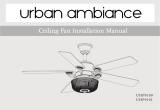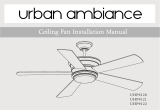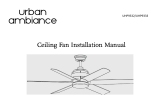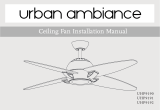Page is loading ...

UHP9230
UHP9231
UHP9232

Safety Rules
Unpacking Your Fan
Installing Your Fan
Setting the Codes on Remote Control and Receiver
Making the Electrical Connections
Finishing the Fan Installation
Operating Your Fan
Care of Your Fan
Troubleshooting
Specications
Table of Contents
1
2
3
5
6
7
9
10
10
11

1. To reduce the risk of electric shock, insure electricity
has been turned off at the circuit breaker or fuse box
before beginning.
2. All wiring must be in accordance with the National
Electrical Code ANSI/NFPA 70-1999 and local electrical codes.
Electrical installation should be performed by a
qualied licensed electrician.
3. CAUTION: To reduce the risk of personal injury, use only
the screws provided with the electrical box.
4. The outlet box and support structure must be securely
mounted and capable of reliably supporting 35 lbs. (15.9
kg). Use only UL Listed outlet boxes marked “Acceptable
for Fan Support of 35 lbs. (15.9 kg) or less.”
5. CAUTION: The fan must be mounted with a minimum of
7 feet clearance from the trailing edge of the blades to the
oor.
6. Do not wait for the fan to stop before pressing the reverse
button. The fan will not reverse direction if the fan is not
moving.
7. Avoid placing objects in path of the blades.
8. To avoid personal injury or damage to the fan and other
items, be cautious when working around or
cleaning the fan.
9. Do not use water or detergents when cleaning the fan or fan
blades. A dry dust cloth or lightly dampened cloth will be
suitable for most cleaning.
10. After making electrical connections, spliced conductors
should be turned upward and pushed carefully up into
electrical box. The wires should be spread apart with the
grounded conductor and the equipment-grounding
conductor on one side of the electrical box and ungrounded
conductor on the other side of the electrical box.
11. Electrical diagrams are for reference only. Light kits that
are not packed with the fan must be UL Listed and marked
suitable for use with the model fan you are installing.
Switches must be UL General Use Switches. Refer to the
instructions packaged with the light kits and switches for
proper assembly.
12. All set screws must be checked and retightened where
necessary before installation.
13. WARNING: To reduce the risk of re or electric shock, do
not use this fan with any solid-state speed control device.
14. This fan should only be used with fan speed control part
no. UC7067RYE, manufactured by Rhine Electronic Co.,
Ltd..
1. Safety Rules
READ AND SAVE THESE INSTRUCTIONS
TO REDUCE THE RISK OF FIRE, ELECTRIC SHOCK OR PERSONAL
INJURY, MOUNT TO OUTLET BOX MARKED “ACCEPTABLE FOR
FAN SUPPORT OF 35 LBS. (15.9 KG) OR LESS”, AND USE SCREWS
PROVIDED WITH THE OUTLET BOX.
TO REDUCE THE RISK OF PERSONAL INJURY, DO NOT BEND THE
BLADE BRACKETS (ALSO REFERRED TO AS (“FLANGES”) DURING
ASSEMBLY OR AFTER INSTALLATION. DO NOT INSERT OBJECTS IN
THE PATH OF THE BLADES.
TO REDUCE THE RISK OF SHOCK, THIS FAN MUST BE INSTALLED
WITH AN ISOLATION CONTROL/SWITCH.

a. Blade attachment hardware
(16 Screws)
b. Electrical hardware and Balancing kit
(3 plastic wire connectors, blade balancing
kit)
5. Light Kit Fitter Assembly
6. Transmitter
7. Blade (5)
1. Mounting Plate (inside canopy)
2. Fan Motor Assembly
3. Light Kit Pan
4. Glass Shade
2. Unpacking Your Fan
Unpack your fan and check the contents. You should have the following items:
ab
1
2
3
4
5
6
7

3. Installing Your Fan
Tools Required
Phillips screw driver or straight slotted screw
driver, adjustable wrench, step ladder, and
wire cutters.
Mounting Options
If there isn’t an existing electrical box, then
read the following instructions. Disconnect
the power by removing fuses or turning off
circuit breakers.
Secure the electrical box directly to the building
structure. Use appropriate fasteners and
building materials. The electrical box and
its support must be able to fully support the
moving weight of the fan (at least 35 lbs.).
Do not use plastic electrical boxes.
Figures 1 and 2 are examples of different ways
to mount the electrical box.
To hang your fan where there is an existing
xture but no ceiling joist, you may need an
installation hanger bar as shown in Figure 3.
TO REDUCE THE RISK OF FIRE, ELECTRIC
SHOCK OR PERSONAL INJURY, MOUNT
TO OUTLET BOX MARKED “ACCEPTABLE
FOR FAN SUPPORT OF 35 LBS. (15.9 KG) OR
LESS”, AND USE SCREWS PROVIDED WITH
THE OUTLET BOX. ELECTRICAL BOXES
COMMONLY USED FOR THE SUPPORT OF
LIGHTING FIXTURES MAY NOT BE ACCEPT-
ABLE FOR FAN SUPPORT AND MAY NEED TO
BE REPLACED. CONSULT A QUALIFIED ELEC-
TRICIAN IF IN DOUBT.
Figure 1
Figure 2
Figure 3

4.
Hanging the Fan
REMEMBER to turn off the power. Follow
the steps below to hang your fan properly.
NOTE: For better fan performance, make
sure the mounting plate is level. Additional
washers (not included) may be needed
to insert between the outlet box and the
mounting plate.
1. Securely attach the mounting plate to the
outlet box using the two screws supplied
with the outlet box. Pull the 120-volt
supply wires (the black, white and ground
wires) out of the outlet box and through
the hole in the mounting plate and lay
them to the side. (Figure 4)
2. Carefully lift the fan-motor assembly and
engage the slot in the motor bracket on
the top of the fan-motor assembly with
the hook on the mounting plate so that it
is securely suspended. (Figure 5)
3. Connect the wiring to your fan according
to “6. Making the electrical connection”.
4. Once the wiring is completed, proceed the
fan installation.
5. Remove two of the four screws (located
diagonally from each other) from the top of
the mounting plate and loosen the other two
screws.
Mounting Plate
Screws (2)
Figure 4
Figure 5
6. Align the two key slots in the top of the
motor housing with the two loosened screws
on the mounting plate. Push the motor
housing up and turn it clockwise to lock in
the mounting plate. Tighten the two screws.
7. Install the two screws that were removed
in step 5 into the remaining two holes and
tighten the four screws rmly.
Figure 6
Screws (4 )
KEEP THE HOOK ON THE MOUNTING PLATE
AWAY FROM THE PRE-INSTALLED RECEIVER.
TURN THE MOUNTING PLATE 180° WHEN
THE MOUNTING PLATE TOUCHES THE PRE-
INSTALLED RECEIVER.

5. Setting the Codes
Setting the Codes
This unit has 16 different code combinations
to prevent possible interference from other
remote units such as garage door openers, car
alarms or security systems.
To set the codes, perform the following steps:
1. Setting the code on the transmitter:
A. Remove the battery cover from the
battery compartment in the back side of
the transmitter.
B. Slide code switches to your choice of
up or down position (factory setting is
up).
C. Replace the battery cover on the battery
compartment of the transmitter.
2. Setting the code on the receiver:
A. Slide code switches to the same
position as set on your transmitter.
Model:UC7085T
FCC ID:CHQ7085T
IC:2968A-7085T
Complies with Canada
RSS-210
MADE IN CHINA
AirproR
1 2 3 4
NECE
12V
1 2 3 4
ON DIP
ON
1 2 3 4
ON DIP
ON
1 2 3 4
NECE
Dip Switches
Transmitter
Receiver
The reverse button
Figure 7

6.
Making the Electrical Connections
EACH WIRE NUT (WIRE CONNECTOR) SUPPLIED
WITH THIS FAN IS DESIGNED TO ACCEPT UP TO
ONE 12 GAUGE HOUSE WIRE AND TWO WIRES
FROM THIS FAN. IF YOU HAVE LARGER THAN
12 GAUGE HOUSE WIRING OR MORE THAN
ONE HOUSE WIRE TO CONNECT TO THE FAN
WIRING, CONSULT AN ELECTRICIAN FOR THE
PROPER SIZE WIRE NUTS TO USE.
USE THE PLASTIC WIRE CONNECTORS
SUPPLIED WITH YOUR FAN. SECURE THE
CONNECTORS WITH ELECTRICAL TAPE AND
ENSURE THERE ARE NO LOOSE STRANDS OR
CONNECTIONS.
BLACK
WHITE
GREEN
Outlet Box
BLACK
BLUE WHITE
WHITE
Figure 8
REMEMBER to disconnect the power. If
you feel you do not have enough electrical
wiring knowledge or experience, have your fan
installed by a licensed electrician. Do not use
solid state fans, electrical wires must meet all
local and national electrical code requirements.
Electrical source and fans must be 115/120
Volt, 60Hz.
Remote control model: UC7067RYE
IF OTHER FAN OR SUPPLY WIRES ARE
DIFFERENT, PLEASE HAVE THIS UNIT
INSTALLED BY A LICENSED ELECTRICIAN.
Follow the steps below to connect the fan to
your household wiring. (Figure 8)
Connect the GROUND conductor of the
120-volt supply to the GREEN wire from the
mounting plate using a wire nut (Figure 8).
Connect the receiver BLACK wire to the
BLACK household supply wire using a wire
nut (Figure 8).
Connect the receiver WHITE wire to the
WHITE neutral household wire using a wire
nut (Figure 8).

Attaching the Fan
Blades
1. Insert the blade through the slot cut-off in
the center ywheel, align the three screw
holes in the blade with the screw holes in
the ywheel and secure with the screws
provided. (Figure 9)
2. Repeat for the remaining blades.
Figure 9
Figure 10
Blade Balancing
All blades are grouped by weight. Because
natural woods vary in density, the fan may
wobble even though the blades are weight
matched.
The following procedure should correct most
fan wobble. Check after each step.
1. Check that all blade screws are secure.
2. Most fan wobble problems are caused
when blade levels are unequal. Check this
level by selecting a point on the ceiling
above the tip of one of the blades. Measure
from a point on the center of each blade
to the point on the ceiling. Measure this
distance as shown in Figure 10. Rotate
the fan until the next blade is positioned
for measurement. Repeat for each blade.
Measurements deviation should be within
1/8”. Run the fan for 10 minutes.
Touching
Ceiling
3. Make sure that motor bracket is tightened
securely to ceiling mounting plate and that
the ceiling mounting plate is tightened
securely to the electrical box.
4. Interchanging two adjacent blades can
redistribute the weight and possibly result
in the smoother operation.
5. Use the enclosed Blade Balancing Kit if the
blade wobble is still noticeable.
Screws (16)
Blade
Flywheel
7. Finishing the Fan Installation

8.
Installing the Light
Kit Pan/Light Kit
Assembly/Glass
Shade
CAUTION - To reduce the risk of electrical
shock, disconnect the electrical supply circuit
to the fan before installing the light kit.
1. Loosen but do not remove two of three
mounting screws from the fan motor
assembly; Remove one mounting screw.
(Figure 11)
2. Push the light kit pan up to the fan motor
assembly so that the two loosened screw
heads t into the keyhole slots. Turn the
light kit pan clockwise, tightened the
screws. Re-install the screw that was
removed in step 1 and tighten rmly.
(Figure 11)
3. Remove one screw from the light kit pan
and loosen, but do not remove the other
two screws. Connect the wires from the
light kit tter assembly to the wires from
the fan motor assembly by connecting the
molded adaptor plugs together. Carefully
tuck all wires and splices into the switch
cap. (Figure 12)
4. Push the light kit tter assembly up so
that the two loosened screw heads t into
the keyhole slots. Turn the light kit tter
assembly clockwise, tighten the screws.
Re-install the screw that was removed in
step 3 and tighten rmly. (Figure 12)
5. Place the glass shade into the light kit
pan, aligning the three at areas on the
top of the glass shade with the three raised
dimples in the light kit pan. Turn the glass
shade clockwise until it stops. (Figure 13)
Light Kit
Pan
Mounting
Screws (3)
Screws (3)
White
Light Kit Fitter
Assemblty
Light Kit Pan
Molded
Adaptor Plugs
White
Black
Blue
Figure 11
Figure 12
Glass
Shade
Flat
Area
Raised
Dimples
Figure 13
PERIODICALLY CHECK THE GLASS SHADE
IS SEATED FULLY CLOCKWISE IN THE LIGHT
KIT PAN

Speed settings for warm or cool weather depend
on factors such as room size, ceiling height,
number of fans, and so on.
Remote control - Your fan is equipped with a
remote control to operate the speed and lights
of your new ceiling fan.
Figure 15
Figure 16
Warm weather - (Forward) A downward air
ow creates a cooling effect as shown in Figure
15. This allows you to set your air conditioner
on a higher setting without affecting your
comfort.
Cool weather - (Reverse) An upward air ow
moves warm air off the ceiling are as shown in
Figure 16. This allows you to set your heating
unit on a lower setting without affecting your
comfort.
9. Operating Your Fan
Key - High speed
Key - Medium speed
Key - Low speed
Key - Light On/Off and Dimmer
Key (inside battery compartment on the
back side of the remote control) -
Fan reverse
Key - Fan off
•••
••
•
Figure 14

10. Care of Your Fan and Troubleshooting
Care of Your Fan
Here are some suggestions to help you
maintain your fan.
1. Because of the fan’s natural movement,
some connections may become loose.
Check the support connections, brackets,
and blade attachments twice a year. Make
sure they are secure. (It is not necessary to
remove fan from ceiling.)
2. Clean your fan periodically to help maintain
its new appearance over the years. Do not
use water when cleaning, this could damage
the motor, or the wood or possibly cause
an electrical shock. Use only a soft brush
or lint-free cloth to avoid scratching the
nish. The plating is sealed with a lacquer
to minimize discoloration or tarnishing.
Warning - Make sure the power is off
before cleaning your fan.
3. You can apply a light coat of furniture polish
to the wood for additional protection and
enhanced beauty. Cover small scratches
with a light application of shoe polish.
4. There is no need to oil your fan.
The motor has permanently lubricated
sealed ball bearings. MAKE SURE THE POWER IS OFF AT THE ELECTRICAL PANEL BOX
BEFORE YOU ATTEMPT TO MAKE ANY REPAIRS. REFER TO THE SECTION,
“MAKING ELECTRICAL CONNECTIONS.”
Fan will not start
Fan sounds noisy
1. Check main and branch circuit fuses or breakers
2. Check line wire connections to the fan and switch wire connections in
the switch housing. CAUTION: Make sure main power is off.
3. Check batteries in the transmitter. Does the red LED light come on?
Are you standing close enough to the fan? (Normal range is 10-20
feet.) Are the dip switch settings the same on the transmitter (hand unit)
and receiver? REMEMBER TO TURN OFF POWER SUPPLY
BEFORE CHECKING THE DIP SWITCH SETTINGS IN
RECEIVER.
1. Make sure all motor housing screws are snug.
2. Make sure the screws that attach the fan blade bracket to the motor hub
are tight.
3. Make sure wire nut connections are not rattling against each other or
the interior wall of the switch housing.
CAUTION: Make sure power is off.
4. Allow a 24-hour “breaking in” period. Most noises associated with a
new fan disappear during this time.
5. If using the Ceiling Fan light kit, make sure the screws securing the
glassware are tight. Check that the light bulb is also secure.
6. Make sure the canopy is a short distance from the ceiling.
It should not touch the ceiling.
7. Make sure your electrical box is secure and rubber isolator pads were
used between the mounting bracket and electrical box.
Troubleshooting
Problem Solution

11. Specications
FAN
SIZE SPEED VOLTS
FAN POWER
CONSUMPTION
(WITHOUT LIGHTS)
WATTS
AIRFLOW
CFM
AIRFLOW
EFFICIENCY
(HIGHER IS BETTER)
CFM/WATT
NET
WEIGHT
GROSS
WEIGHT
CUBE
FEET
52”
Low
120
13 1640 126 19.84
Lbs
22.93
Lbs 2.4
Med 28 2872 103
High 62 4276 69
This equipment has been tested and found to comply with the limits for a Class B digital device, pursuant to Part 15 of the FCC Rules. These limits
are designed to provide reasonable protection against harmful interference in a residential installation. This equipment generates, uses and can radiate
radio frequency energy and, if not installed and used in accordance with the instructions, may cause harmful interference to radio communications.
However, there is no guarantee that interference will not occur in a particular installation. If this equipment does cause harmful interference to radio
or television reception, which can be determined by turning the equipment off and on, the user is encouraged to try to correct the interference by one
or more of the following measures:
--Reorient or relocate the receiving antenna.
--Increase the separation between the equipment and receiver.
--Connect the equipment into an outlet on a circuit different from that to which the receiver is connected.
--Consult the dealer or an experienced radio/TV technician for help.
CAUTION:
Any changes or modications not expressly approved by the grantee of this device could void the user’s authority to operate the equipment.
This device complies with Part 15 of the FCC Rules. Operation is subject to the following two conditions: (1) This device may not cause harmful
interference, and (2) this device must accept any interference received, including interference that may cause undesired operation.
/








